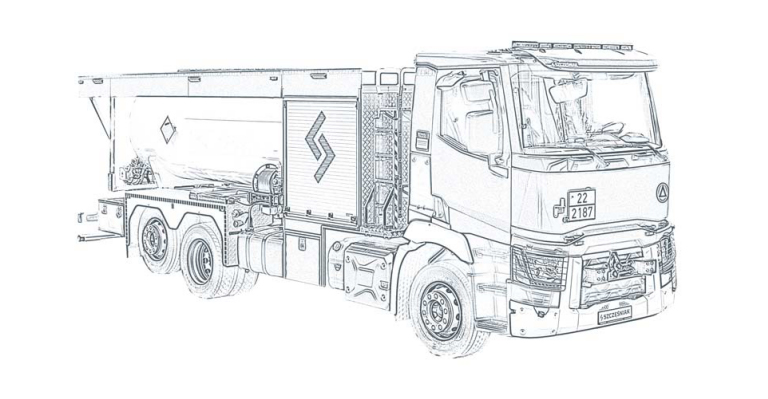


Samochód gaśniczy proszkowy to pojazd pożarniczy z zamontowanym agregatem proszkowym. Środkiem gaśniczym jest proszek gaśniczy, który jest przewożony w stalowym zbiorniku ciśnieniowym. Agregat proszkowy jest wyposażony w instalację proszkową składającą się z: przewodów ciśnieniowych, zaworów, linii szybkiego natarcia na zwijadłach, proszkowego działka gaśniczego, a także z butli z gazem lub sprężarki powietrza do dostarczenia czynnika do wyrzutu proszku. Zbiorniki mogą mieć różną pojemność, zazwyczaj są to wielkości: 250 kg, 750 kg, 1000 kg, 1500 kg, 2000 kg, 3000 kg, 5000 kg lub 6000 kg proszku. Najczęściej stosowanym rozwiązaniem do wyrzutu proszku gaśniczego jest zestaw kilku butli, każda po 40 l lub 50 l z azotem sprężonym pod ciśnieniem 150 barów. Samochód gaśniczy śniegowy to pojazd pożarniczy przystosowany do przewożenia ciekłego dwutlenku węgla (CO 2 ), urządzeń gaśniczych wraz z instalacją i liniami szybkiego natarcia. Najczęściej ten typ samochodu jest budowany na podwoziu kategorii 1, czyli miejskiej, jednak może to być także samochód kategorii 2 lub 3.
A powder extinguishing vehicle is a firefighting vehicle with an installed DCP powder aggregate. Th e extinguishing agent is dry chemical powder, which is transported in a pressurized tank made of steel. Moreover, a powder unit of this type is equipped with a powder installation consisting of: pressure lines, valves, quick attack hose reels, a powder fi re-extinguishing monitor, as well as a gas cylinder or an air compressor to deliver the powder ejection agent. The tanks can have various capacities, usually of: 250, 750, 1000, 1500, 2000, 3000, 5000 and 6000 kg of powder. Th e most commonly used solution for the discharge of extinguishing powder is a set of several cylinders, 40 or 50 l each, with nitrogen compressed at a pressure of 150 bar. A snow extinguishing vehicle is a fi refi ghting vehicle adapted to transport liquid carbon dioxide, fi re extinguishing devices with installation and quick attack hose reel lines. Most oft en, this type of vehicle is built on a category 1 (municipal) chassis, but it can also be built on a category 2 or 3 (off road).
Fot. 1. Średni samochód proszkowy Iveco EuroCargo ML120E28W (4×2), wyposażony w dwa agregaty proszkowe AP 250 – każdy o pojemności 250 kg proszku.
Photo 1. Medium-class powder vehicle Iveco EuroCargo ML120E28W (4×2) equipped with two AP 250 powder units of the capacity of 250 kg of powder each.
Fot. 2. Średni samochód proszkowo-śniegowy MAN 14.224 LC (4×2), wyposażony w dwa agregaty proszkowe AP 1500 – każdy o pojemności 1500 kg proszku, agregat śniegowy z butlami z 480 kg dwutlenku węgla (CO2).
Photo 2. Medium-class powder vehicle MAN 14.224 LC (4×2) equipped with two AP 1500 powder units of the capacity of 1500 kg of powder each, and a snow unit with cylinders with 480 kg of carbon dioxide (CO2).
Fot. 3. Średni samochód proszkowy MAN 14.225 LC (4×2), wyposażony w agregat proszkowy AP 3000 o pojemności 3000 kg proszku oraz AP 250 o pojemności 250 kg proszku.
Photo 3. Medium-class powder vehicle MAN 14.225 LC (4×2) equipped with AP 3000 powder unit of the capacity of 3000 kg of powder and AP 250 of the capacity of 250 kg of powder.
Fot. 4. Średni samochód proszkowy Renault Midlinder M150 (4×2), wyposażony w dwa agregaty proszkowe AP 1500 – każdy o pojemności 1500 kg proszku oraz agregat AP 250 o pojemności 250 kg proszku.
Photo 4. Medium-class powder vehicle Renault Midlinder M150 (4×2) equipped with two AP 1500 powder units of the capacity of 1500 kg of powder each, and AP 250 unit of the capacity of 250 kg of powder.
Fot. 5. Ciężki samochód proszkowy MAN TGA 26.363 FDC (6×4), wyposażony w dwa agregaty proszkowe AP 3000 – każdy o pojemności 3000 kg proszku oraz AP 250 o pojemności 250 kg proszku.
Photo 5. Heavy-class powder vehicle MAN TGA 26.363 FDC (6×4) equipped with two AP 3000 powder units, each of the capacity of 3000 kg of powder, and AP 250 unit of the capacity of 250 kg of powder.
Fot. 6. Ciężki samochód proszkowo-śniegowy Scania P280B4X2NB XT (4×2), wyposażony w dwa agregaty proszkowe AP 1500 – każdy o pojemności 1500 kg proszku, agregat śniegowy z butlami z 240 kg dwutlenku węgla (CO2), dwa mobilne półstałe urządzenia gaśnicze (po 30 kg) ze środkiem gaśniczym FE-36TM.
Photo 6. Heavy-class powder-snow vehicle Scania P280B4X2NB XT (4×2) equipped with two AP 1500 powder units of the capacity of 1500 kg of powder each, a snow aggregate with cylinders with 240 kg of carbon dioxide (CO2), two mobile semi-permanent fi re extinguishing devices (a’ 30 kg) with FE-36TM extinguishing agent.
Fot. 7. Ciężki samochód proszkowo-śniegowy Scania R370DB4X2HNZ (4×2), wyposażony w dwa agregaty proszkowe AP 1500 – każdy o pojemności 1500 kg proszku, agregat śniegowy z butlami z 240 kg dwutlenku węgla (CO2), dwa mobilne półstałe urządzenia gaśnicze (po 30 kg) ze środkiem gaśniczym FE-36TM.
Photo 7. Heavy-class powder-snow vehicle Scania R370DB4X2HNZ (4×2) equipped with two AP 1500 powder units of the capacity of 1500 kg of powder each, a snow aggregate with cylinders with 240 kg of carbon dioxide (CO2), two mobile semi-permanent fire extinguishing devices (a’ 30 kg) with FE-36TM extinguishing agent.
Fot. 8. Ciężki samochód śniegowo-proszkowy Renault Trucks C380 P6X2 E6 (6×2), wyposażony w zbiornik ciśnieniowy na dwutlenek węgla (CO2) o pojemności 4533 l, agregat proszkowy AP 250 o pojemności 250 kg proszku, agregat prądotwórczy o mocy 8,7 kVA.
Photo 8. Heavy-class snow-powder vehicle Renault Trucks C380 P6X2 E6 (6×2) equipped with a pressure tank for carbon dioxide (CO2) of the capacity of 4533 l, AP 250 powder unit of the capacity of 250 kg of powder, and a 8,7 kVA power aggregate.